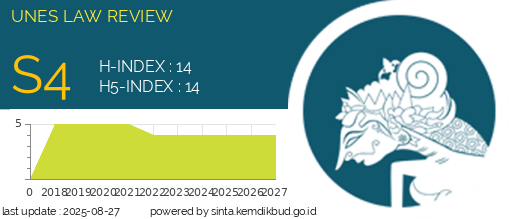THIRD PARTY LEGAL PROTECTION AS A GOOD-INTENTION BUYER OF LAND WHICH IS INDICATED ABANDONED
DOI:
https://doi.org/10.31933/unesrev.v5i4.709Keywords:
Legal Protection, Abandoned Land, Third Party, GoodwillAbstract
The problem studied in this final assignment islegal protection for third parties as buyers with good intentions for indicated abandoned land, so that it is known how the procedures for possession of abandoned indicated land are known, what are the legal consequences for land indicated as abandoned if it is sold by the right holder to a third party, and what is the legal protection for third parties as a willing buyer either on land indicated as abandoned. Based on this research, it was found that the government's authority regarding state rights in carrying out control of abandoned land is the duty and function of the Ministry of Agrarian Affairs and Spatial Planning/Head of the National Land Agency. Land becomes an object of abandoned land tenure if it is deliberately not cultivated, used and utilized in accordance with the purpose of granting the rights obtained. The process of controlling abandoned land is carried out in several stages, including: evaluation of abandoned land, notification, warning of abandoned land, proposal for designation of abandoned land if after the expiration of the third warning period the land remains abandoned, and determination of abandoned land which includes abolition of land rights, termination of law between land rights holders and their land, and affirmation that the land is directly controlled by the state. The legal consequences for third parties who acquire land through buying and selling plots of land that are indicated as abandoned are because there is no prohibition in the implementation of land registration, where the prohibition on legal action only applies to objects that have been proposed to be designated as abandoned land.
Downloads
References
Harsono, B. (2005). Hukum Agraria Indonesia Sejarah Pembentukan Undang-Undang Pokok Agraria, Isi Dan Pelaksanaannya Jilid 1 Hukum Tanah Nasional. Djembatan.
Lexy J. Moleong. (2018). Metode Penelitian Kualitatif. PT Remaja Rosdakarya, 2018.
Undang-Undang Nomor 5 Tahun 1960 Tentang Peraturan Dasar Pokok-Pokok Agraria, 33 (21 C.E.).
Soekamto, S. (1983). Pengantar Penelitian Hukum. UI Press.
Subekti. (2015). Arbitrase Perdagangan, Bina Cipta, Bandung. Bina Cipta.
Subekti. (2016). Subekti, Aneka Perjanjian, Citra Aditya Bakti, Bandung, 1995, Hal. Citra Aditya Bakti.
Subekti, R. (2014). Aneka Perjanjian,. Citra Aditya Bakti.
Sugiyono. (2019). Metode Penelitian Kuantitatif, Kualitatif, R&D.
Syahrani, R. (2013). Seluk Beluk Dan Azas-Azaz Hukum. Alumni Press.
Downloads
Published
How to Cite
Issue
Section
License
Hak cipta :
Penulis yang mempublikasikan manuskripnya di jurnal ini menyetujui ketentuan berikut:
- Hak cipta pada setiap artikel adalah milik penulis.
- Penulis mengakui bahwa UNES Law Review berhak menjadi yang pertama menerbitkan dengan lisensi Creative Commons Attribution 4.0 International (Attribution 4.0 International CC BY 4.0) .
- Penulis dapat mengirimkan artikel secara terpisah, mengatur distribusi non-eksklusif manuskrip yang telah diterbitkan dalam jurnal ini ke versi lain (misalnya, dikirim ke repositori institusi penulis, publikasi ke dalam buku, dll.), dengan mengakui bahwa manuskrip telah diterbitkan pertama kali di Jurnal UNES Law Review.



















